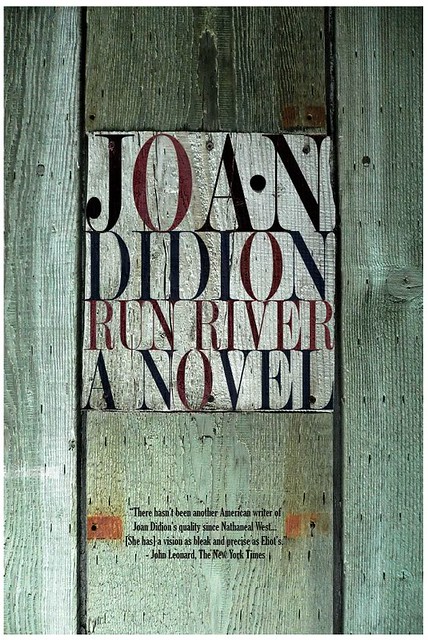Joan Didion is a prolific writer of the authentic
American experience. In university, I wrote my honours paper on Didion, so had
the opportunity to read all of her works, some of them several times. Despite
this, I was always newly struck by her powers of description, and her ability
to convey so much with so very few words – the quintessential sign of a natural
born writer.
We typically tend to forget specific details about books
we read; we are merely left with an impression or feeling about the work,
whether it be positive, negative, intrigued or bemused. Although I never wrote
a paper about Run River, it was a
book that always left an impression on me. The feeling is somewhat
indescribable (if only I had Didion’s way with words), but the book always conjured
a dark, country road meandering alongside a river, an ominous feeling in the
air. I could see car headlights on that road, or shining deep in that river.
Ten years later and I pick up the book again, to find out
more about this car and this river, and why it made a difference to me as a
reader. Written in 1963, but set in the 1930s-50s, Run River pivots around the story of Lily McClennan, and how her
many trysts get both her and her marriage into trouble. It also touches on the
history of California, both Lily and her husband Everett having descended from
pioneers, their families made wealthy by land ownership and farming. It is a
time of religion and racism, and in the background the sense that California,
the land of milk and honey, can fulfill the American dream.
However, this dream is overshadowed by disloyalty and
dysfunction, and the idea that what one has is never good enough. There is the
looming possibility of breaking with tradition and selling the family farm to
larger shareholders; Everett is “fighting the war” in Texas instead of helping
his family; and intelligent, good looking Martha, Everett’s sister, can’t seem
to get her life on the right track. And then there’s Lily, whose loose morals
are uncharacteristic of her time. With a reputation for having affair after
affair, her nonchalance about sleeping with other men is troublesome. Lily
seems to do it out of habit, gaining little from these intimate moments, which
would somehow make them more excusable. Perhaps this is Didion’s way of saying
how easily we take advantage of what we have, with little to gain by putting
everything on the line.
There are many references to the unbearable weather near
Sacramento; it’s either exhaustingly hot or raining, and we get many scenes of Lily
alone, shut up in her bedroom against the heat, some liquor or another on her
bedside table. In fact, most of the women in this story drink alcohol like
they’d drink their tea – anytime of day will do. It sometimes reads like a
Desperate Housewives of the 1940s and 50s, full of gossip, ill intentions and
forbidden love triangles.
Despite Lily being somewhat unlikeable, her
characterization and the novel’s plot in general, strike me as a realistic view
on the difficulties of living up to society’s, your parents’, or even your own
expectations. I particularly like that Didion lived through the 1950s, and has
a more visceral understanding of what that meant. Although I am enamored by
many historical pieces about the post-war era, they are often written by people
who never lived those moments. And Didion’s no-nonsense style of storytelling
is typical of all her work – she effortlessly characterizes the truths of human
nature, all the good, the bad, and the ugly. At times, the novel is
unnecessarily complicated, but I chalk this up to it being Didion’s first
novel, before honing her craft.
So what did the river and those lights represent in the
end? The rain, the river, the cycle of life and that we are destined to repeat
our ancestors’ mistakes? Maybe. The car sinking in the river, its headlights
slowly fading away – the extinguished American dream? Perhaps. Regardless, that
image will forever stay with me, and it will keep bringing me back to the
merits of Joan Didion and Run River.






